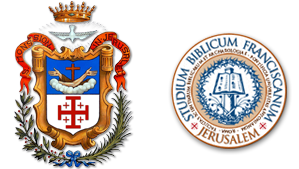...................................
[read in Italian] ![]()
The plan of the Church of the Nativity in Bethlehem (1609, plate 1) is the first plate of the Trattato and it is extremely accurate and detailed. The building preserves the 6th century early Christian structure with five aisles and a wooden ceiling. The mosaics which covered the interior walls, of which only a part survived, were subjected to essential restoration works between 2013 and 2020. Amico focuses on the church in detail and he describes its various elevations in different chapters. This allows him to be very specific, mentioning for instance the small entrance to the atrium, which prevented entry on horseback, and the «bar» (1620, fol. A1r and Plans, p. 42) used to close it in case of Ottomans’ attacks.
| [click sulle immagini per ingrandirle / click on images to enlarge] |
The large drawing of the elevation of the Church of the Nativity (1609, plate 2), immediately following its plan, is «drawn in perspective». The line on the top of the plate indicates the distance from which the observer should look at the image with one eye, keeping the other one closed. This should give a three-dimensional perspective to the illustration. Amico himself provides very detailed instructions to the reader: «To see […] properly and distinctly it is necessary to take its point or centre with its proportionate distance, which is shown by the line drawn above the design itself, being careful however, not to do what some do, who taking the map in hand set their eye on that of the line and view it crosswise: one should take the design in hand and closing one eye, with the other see the point at a distance equal to that of the line, which shows it in majestic facade or, as we would say, in frontispiece, and out of place according as the figure is made; and fixing the eye in a straight line, and then turning it without moving the head, the whole will be seen in relief as if it were built of material» (1620, fol. C1r and Plans, p. 48). This confirms how much care and attention Amico put into his treatise, pointing out all its peculiarities.
The Milk Grotto is located not far from the Church of the Nativity. Here Mary might have nursed the baby Jesus during their escape from Herod’s soldiers. This place is still visited by many pilgrims, especially by women (Jewish, Christian and Muslim) who pray to the Virgin for milk to feed their children. Even Bernardino Amico talks about this devotion when he writes: «And there you find that holy grotto, in which the most Blessed Virgin hid herself with her Son, Christ Our Lord, on instructions from St. Joseph, when he was warned by the angel to go into Egypt: and here while suckling the glorious Infant, on account of an abundance of milk, they say, there fell some drops on the ground, and for this the place has received a special grace, so that not only the Christians but also the unbelievers every day take of these stones, and having washed them in water they give the water to their animals, when for any reason the mother’s milk is wanting. And these crushed stones are up to this day called milk of the Madonna» (1620, fol. B1v and Plans, p. 47).
